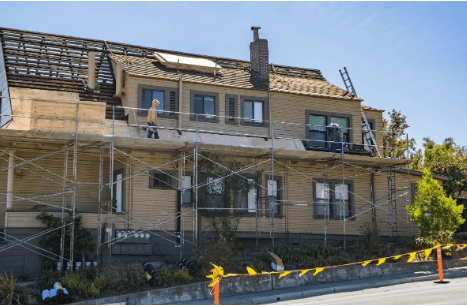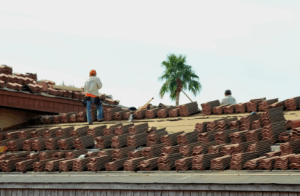
A roof replacement is a significant investment, and getting it right can save you from future headaches. Whether your roof is showing signs of wear or has sustained storm damage, knowing what to expect and how to avoid common mistakes ensures the process runs smoothly. The right preparation and contractor can make all the difference in durability, cost-effectiveness, and overall satisfaction. Companies like IronHead Roofing click here for more have built a reputation for quality workmanship, making the selection of a trusted contractor an essential first step.
Understanding When a Roof Replacement Is Necessary
Many homeowners wonder whether a repair will suffice or if a full roof replacement is necessary. While minor issues like small leaks or a few missing shingles might be fixable, some warning signs indicate it’s time for a new roof:
- Age of the Roof – Asphalt shingles typically last 20-25 years, while metal and tile roofs have longer lifespans. If your roof is approaching the end of its expected lifespan, replacement is the best course of action.
- Frequent Repairs – If you find yourself calling for repairs multiple times a year, investing in a new roof may be more cost-effective in the long run.
- Visible Damage – Cracked, curled, or missing shingles, sagging, or extensive water damage all point to the need for a replacement.
- Moss and Algae Growth – While this might seem like a cosmetic issue, excessive growth can trap moisture and accelerate deterioration.
Choosing the Right Roofing Material
A key decision in the roof replacement process is selecting the right material. Here’s a breakdown of some popular options:
- Asphalt Shingles – Affordable and widely used, these offer a balance of durability and cost-effectiveness.
- Metal Roofing – Highly durable and energy-efficient, metal roofs can last up to 50 years or more.
- Clay or Concrete Tiles – These provide a distinct aesthetic and exceptional longevity but require strong structural support.
- Wood Shingles and Shakes – Known for their natural look, these require maintenance to prevent mold and rot.
- Slate Roofing – A high-end option with unmatched longevity but comes with a higher price tag and requires expert installation.
Common Mistakes to Avoid During Roof Replacement
1. Choosing the Cheapest Contractor
While budget is important, the cheapest bid often comes with subpar materials or poor workmanship. Research multiple contractors, check reviews, and verify licensing and insurance before making a decision.
2. Not Checking for Underlying Issues
A proper roof replacement isn’t just about swapping out old shingles. Issues like rotting decking or poor ventilation should be addressed to prevent future damage. Ensure your contractor conducts a thorough inspection.
3. Ignoring Ventilation Needs
Poor ventilation leads to moisture buildup, which can cause mold, rot, and increased energy bills. Discuss ventilation options with your contractor to prolong your roof’s lifespan.
4. Skipping the Warranty Details
Different manufacturers and contractors offer varying warranties. Ensure you understand the coverage for both materials and workmanship to avoid unexpected costs down the line.
5. Neglecting to Prepare Your Home
A roof replacement can be messy. Take precautions such as covering valuables in the attic, moving vehicles away from the work area, and informing neighbors about potential noise disruptions.
Maximizing the Results of Your Roof Replacement
1. Hire a Reputable Contractor
Look for licensed, insured, and experienced contractors with positive customer feedback. Ask for references and check previous projects to assess their quality of work.
2. Choose Quality Materials
While premium materials may cost more upfront, they offer better durability, energy efficiency, and curb appeal, saving you money on repairs and replacements in the long run.
3. Plan for the Right Season
Spring and early fall are ideal for roof replacement projects. Harsh winter weather or extreme summer heat can affect installation quality and timelines.
4. Communicate Clearly with Your Contractor
Stay informed about the project timeline, potential issues, and cost breakdowns. A good contractor will keep you updated and answer any questions you have along the way.
5. Regular Maintenance After Installation
To extend the lifespan of your new roof, schedule regular inspections, clean gutters, and address minor issues before they escalate into costly problems.
6. Consider Energy-Efficient Options
Choosing reflective or energy-efficient materials can help reduce heating and cooling costs. Options like cool roofs or solar-compatible shingles can further enhance energy savings.
7. Protect Landscaping and Outdoor Features
Roofing projects involve a lot of debris. Cover garden beds, move patio furniture, and take precautions to minimize potential damage to your yard.
8. Know What to Expect After Installation
Even with professional installation, new roofs need time to settle. Asphalt shingles may take a few weeks to fully adhere, and minor granule shedding is normal in the beginning. Keep an eye out for any major concerns and schedule a follow-up inspection if needed.
Final Thoughts
A roof replacement is a major investment, but with careful planning and the right choices, it can be a smooth and rewarding process. Avoid common pitfalls by choosing an experienced contractor, investing in quality materials, and staying proactive in maintenance. The right approach ensures your home remains safe, energy-efficient, and visually appealing for years to come. Whether you’re tackling the project now or planning for the future, taking the right steps will help you maximize the value and longevity of your new roof.





